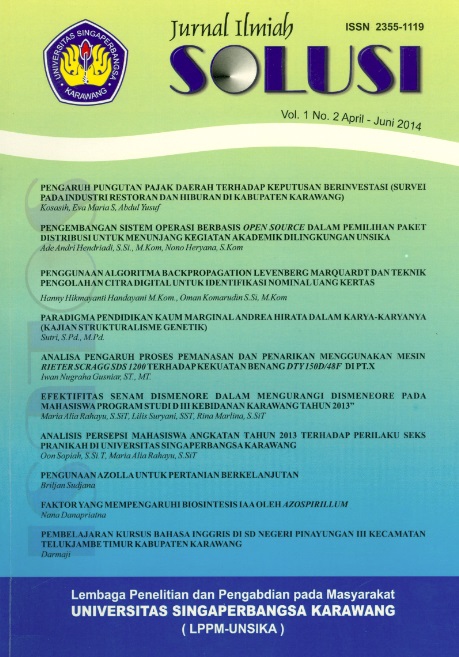FAKTOR YANG MEMPENGARUHI BIOSINTESIS IAA OLEH AZOSPIRILLUM
DOI:
https://doi.org/10.35706/solusi.v1i02.50Abstract
Auxin is a growth hormone that can be produced by bacteria, including Azospirillum. Pyruvate indole 3 acetic acid (IAA) is one form of auxin which can be produced by Azospirillum. The main precursor in the formation of IAA by Azospirilum is tryptophan. IAA biosynthesis by Azospirillum consists of the major pathway Indole 3 pyruvate and minor pathway through Tryptamine. Production of IAA by Azospirilum influenced by genetic factors and environmental factors. Genes involved in the production process of IAA by Azospirillum is ipdC gene that determines the formation of pyruvate decarboxylase enzyme indole 3. Environmental factors that influence the IAA biosynthesis is the availability of carbon, medium pH, oxygen and nitrogen. Production of IAA by Azospirillum increased under conditions of limited availability of carbon and low pH of medium. Provision of nitrogen can increase the production of IAA. Aerobic environmental conditions resulted in the production of IAA by Azospirillum be lower compared to anaerobic conditions (oxygen limited). This paper describes the biosynthesis of IAA by Azospirillum through pathways involving tryptophan as the precursor and the factors that influence it.
Key Words : Azospirilum, IAA, Tryptophan, Indole-3-pyruvate, Tryptamine
Downloads
References
Akbari, G.A., S.M. Arab, H.A. Alikhani, I. Allahdadi and M.H. Arzanesh. 2007. Isolation and selection of indigenous Azospirillum spp. and the IAA of superior strains effect on wheat roots. World J. Agric. Sci. 3 : 523 – 529.
Aryantha, I.N.P., D.P Lestar dan N.P.D. Pangesti. 2004. Potensi isolat bakteri penghasil IAA dalam peningkatan pertumbuhan kecambah kacang hjau pada kondisi hidroponik. J.Mikrobiol.Indones. 9 : 43 – 46.
Broek, A.V., P. Gysegom, O. Ona, N. Hendrickx, E. Prinsen, J.V. Impe and J. Vanderleyden. 2005. Transcriptional analysis of the Azospirillum brasilense indole-3-pyruvate decarboxylase gene and identification of a cis-acting sequence involved in auxin responsive expression. MPMI 18 : 311 – 323.
Crozier, A., P. Aruda, J.M. Jamin, A.M. Monteiro and G. Sandberg. 1988. Analyss of indole-3acetic acid and related indoles in culture medium from Azospirillum lipoferum and Azospirillum brasilense. Appl. Environ. Microbiol. 54 : 2833 - 2837.
de-Bashan, L.E., H. Antoun and Y. Bashan. 2008. Involvement of indole-3-acetic acid produced by the growth-promoting bacterium Azospirillum spp. in promoting growth of Chorella vulgaris. J.Phycol. 44 : 983 – 947.
Danapriatna, N., R. Hindersah, dan Y. Sastro. 2010. Pengembangan pupuk hayati Azotobacter dan Azospirillum untuk meningkatkan produktivitas dan efisiensi penggunaan pupuk N di atas 15% pada tanaman padi. Laporan penelitian KKP3T No SPKPP : 1148/LB.602/I.1/4/2010. LPPM Universitas Islam “45†Bekasi Bekerjasama dengan Badan Penelitian dan Pengembangan Pertanian.
Husen, E. 2003. Screening of soil bacteria for plant growth promotion activities in vitro. Indones. J. Agric. Sci. 4 : 27 - 31
Lee, W.K, J.Y. Lee, K.Y. Kang and M.J. Cho. 1988. Synthetic pathway of indole acetic acid in Azospirillum lipoferum. Korean Biochem. J. 21 : 519 – 524.
Lestari, P., D.N. Susilowati dan E.I. Riyanti. 2007. Pengaruh hormon asam indol asetat yang dihasilkan Azospirillum sp. terhadap perkembangan akar. Jurnal Agro Biogen 3 : 66 – 72.
Normanly, J., J.P. Slovin and J.D. Cohen. 1995. Rethinking auxin biosynthesis and metabolism. Plant Physiol. 107 : 323 – 329.
Ona, O., J.V. Impe, E. Prinsen and J. Vanderleyden. 2005. Growth and indole-3acetic acid biosynthesis of Azospirillum brasilense Sp245 is environmentally controlled. FEMS Microbiology Letters 246 : 125 – 132.
Patten, C.L. and B.R. Glick. 2002. Role of Pseudomonas putida indole acetic acid in development of the host plant root system. Appl. Environ. Microbiol. 68 : 3795 – 3801.
Silva, T. and P.J. Davies. 2007. Elongation rates and endogenous indoleacetic acid levels in roots of pea mutants differing in internode length. Physiol. Plant. 129 : 804 -812
Somers, E., D. Ptacek, P. Gysegom, M Srinivansan and J. Vanderleyden. 2005. Azospirillum brasilense produces the auxin-like phenylacetic acid by using the key enzime for indole-3acetic acid biosynthesis. Appl. Environ. Microbiol. 71 : 1803 – 1810.
Spaepen, S. J. Vanderleyden and R. Remans. 2007a. Indole-3-acetic acid in microbial and microorganism-plant signaling. FEMS Microbiol. Rev.: 1 – 24.
Spaepen, S., W. Versees, D. Gocke, M. Pohl, J. Steyaert and J. Vanderleyden. 2007b. Characterization of phenylpyruvate decarboxylase, involved in auxin production of Azospirillum brasilense. J. Bacteriol. 189 : 7626 – 7633.
Steenhoudt, O. and J. Vanderleyden. 2000. Azospirillum, a free-living nitrogen fixing bacterium closely associated with grasses : genetic, biochemical and ecological aspects. FEMS Microbiol. Rev. 24 : 487 - 506.
Zakharova, E.A., A.A. Shcherbakov, V.V. Brudnik, N.G. Skripko, N.S.Bulkhin and V.V. Ignatov. 1999. Biosynthesis of indole-3-acetic acid in Azospirillum brasilense. Insight from quantum chemistry. Eur. J. Biohem. 259 : 572 – 576.

